|
|
|
Sort Order |
|
|
|
Items / Page
|
|
|
|
|
|
|
| Srl | Item |
| 1 |
ID:
037803
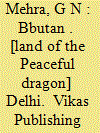

|
|
|
|
|
| Publication |
DelhI, Vikas Publishing House Pvt Ltd, 1974.
|
| Description |
xiv, 151p.hbk
|
| Standard Number |
0706903102
|
|
|
|
|
|
|
|
|
|
|
|
Copies: C:1/I:0,R:0,Q:0
Circulation
| Accession# | Call# | Current Location | Status | Policy | Location |
| 013405 | 954.98/MEH 013405 | Main | On Shelf | General | |
|
|
|
|
| 2 |
ID:
089790
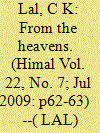

|
|
|
|
|
| Publication |
2009.
|
| Summary/Abstract |
If heaven is a place of eternal peace, irrepressible joy and complete bliss, then it must remain somewhere in the imagination -that is the only place where in the imagination that is the only place where ideas need not reflect reality. But if it is an address where Gods and Angles live, it must be a place very similar to Tibet. Kailash, a mountain metaphorically higher than the Himalaya, and Mansarovar, a lake subliminally deeper than the pacific ocean, are both located on the Tibetan plateau. And biggest has to be heaven because some of the biggest river systems which sustain nearly half of the world's population, originate in its highlands,
|
|
|
|
|
|
|
|
|
|
|
|
|
|
|
|
| 3 |
ID:
179349


|
|
|
|
|
| Summary/Abstract |
This paper argues that the incipient tensions over the Brahmaputra between India and China has become a considerable threat and cause for concern to the downstream dwellers of India's North East Region (NER), especially Assam and Arunachal Pradesh. It enlarges the term ‘Brahma-hypothesis' and considers Chinese ‘hydro-hegemony' over the Brahmaputra as a ‘national security' threat to India. It also argues that apart from having the occasional Memorandum of Understanding (MoU) with China, India should seek to develop with China and other countries a multilateral diplomatic agreement regarding the management of the Brahmaputra River to secure India’s vital interests at national and regional levels. This is also necessary to minimise the sense of insecurity continuously growing in the minds of the people of the NER.
|
|
|
|
|
|
|
|
|
|
|
|
|
|
|
|
| 4 |
ID:
188745


|
|
|
|
|
| Summary/Abstract |
This essay offers an introduction to a special section on ecology and performance in South Asia. Aiming at ‘green’ studies of music and performance, this collection explores intersections between ethnography, history, eco- and ethnomusicology, and film and performance studies by paying particular attention to the ecological turn more broadly visible in South Asian studies. The papers address varied ecological settings of South Asian music and performance, from riverscapes to coastal communities, and from the locations of instrument-makers to negotiations of the climate crisis and the COVID-19 pandemic. The novelty of the section lies not just in mapping the dialogism between ecology and music through reflections on liminality, gender, resistance and identity, but also in bringing forth new archival strategies (digitisation and digital cultures) in conversation with ethnographic findings.
|
|
|
|
|
|
|
|
|
|
|
|
|
|
|
|
| 5 |
ID:
106934


|
|
|
| 6 |
ID:
034529


|
|
|
|
|
| Publication |
New York, McGraw-Hill Book Company, Inc., 1963.
|
| Description |
ix, 422p.Hbk
|
|
|
|
|
|
|
|
|
|
|
|
Copies: C:1/I:0,R:0,Q:0
Circulation
| Accession# | Call# | Current Location | Status | Policy | Location |
| 000034 | 910.132/POU 000034 | Main | On Shelf | General | |
|
|
|
|
| 7 |
ID:
106935


|
|
|
|
|
| Publication |
2011.
|
| Summary/Abstract |
Water scarcity is popularly associated with inter-state conflict, yet the academic literature also touts scarcity as an important variable for understanding cooperation over international freshwater. Building on studies that consider the relationship between scarcity and hydro-political cooperation, this paper empirically investigates why water treaties are negotiated for some rivers and between some riparians, and not others. Rather than considering a linear relationship between scarcity and cooperation, this study hypothesizes a curvilinear relationship expecting agreements to emerge in situations where scarcity is moderate rather than very low or high. Additional variables considered for understanding treaty formation include level of governance among the riparian states, prevailing power dynamics along the river, overall inter-riparian relations (measured by trade, diplomatic ties, and militarized disputes), and the geographical configuration of the entire river. The hypothesized curvilinear relationship between water scarcity and cooperation finds significant support in the empirical analyses. Governance, diplomatic relations, and trade are likewise found to be salient in explaining the levels of cooperation. The geographical configuration of the river was significant in only part of the estimates, and the militarized disputes variable was found to be insignificant across all models. Finally, while results confirm that cooperation may not depend on power asymmetries within riparian dyads, as suggested by some theories, the paper does find support for the contention that more developed states are in a position to provide incentives, such as financial transfers, to less-developed states so as to facilitate an international agreement.
|
|
|
|
|
|
|
|
|
|
|
|
|
|
|
|
| 8 |
ID:
088818
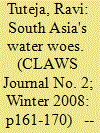

|
|
|
| 9 |
ID:
037119


|
|
|
|
|
| Publication |
London, Longmans, 1967.
|
| Description |
xxvi, 379p.Hbk
|
|
|
|
|
|
|
|
|
|
|
|
Copies: C:1/I:0,R:0,Q:0
Circulation
| Accession# | Call# | Current Location | Status | Policy | Location |
| 000558 | 911.47/JOR 000558 | Main | On Shelf | General | |
|
|
|
|
| 10 |
ID:
124288
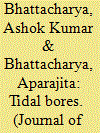

|
|
|
|
|
| Publication |
2013.
|
| Summary/Abstract |
A tidal bore is a spectacular tidal phenomenon in which the leading edge of the incoming tide forms of wave (or number of waves) that travels up a river or narrow bay against the direction of the river or bay's current it is a passive surge of tidal origin that forms when a rising tide enters a shallow, gently sloping and narrowing river from a board funnel mouthed estuary.
|
|
|
|
|
|
|
|
|
|
|
|
|
|
|
|
| 11 |
ID:
172563
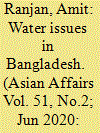

|
|
|
|
|
| Summary/Abstract |
At present, Bangladesh is self-sufficient in water. However, this self-sufficiency is by no means assured. Bangladesh's supplies of water are under threat through a combination of population growth, climate change, and pollution, sometimes caused by mismanagement. This article looks at the state of surface and ground waters in Bangladesh. It discusses the growing demand for water, pollution of the water bodies, and encroachment on the riverbeds, and the way in which this has been dealt with by Bangladesh's authorities. It argues that if things remain business-as-usual, it will become difficult for Bangladesh to continue with its high growth rate over the long term.
|
|
|
|
|
|
|
|
|
|
|
|
|
|
|
|
| 12 |
ID:
139819
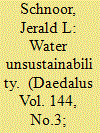

|
|
|
|
|
| Summary/Abstract |
Water is a vital renewable resource that is increasingly stressed by multiple and competing demands from people, industry, and agriculture. When water becomes unavailable or unusable, life itself cannot be sustained. Changes in supply and demand for water are driven by population growth, climate change, and our energy and land use choices. Poverty frequently precludes the ability of many people to respond and adapt to water insecurity. In this essay, we discuss the effects of these drivers on the diminution of rivers, aquifers, glaciers, and the severe pollution that renders some water resources unusable. While technologies for water reuse, desalination, aquifer replenishment, and better water pricing are important solutions, the recognition of water as a profoundly threatened resource and as a basic human right is essential for providing sustainable water for future generations.
|
|
|
|
|
|
|
|
|
|
|
|
|
|
|
|
|
|
|
|
|